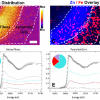A. Marcelli,a D. Hampai,a G. Cibinb and V. Maggic,d
aINFN–Laboratori Nazionali di Frascati, Via E. Fermi 40, 00044 Frascati, Italy
bDiamond Light Source, Chilton, Didcot, Oxon OX11 0DE, UK
cDipartimento Scienza Ambiente e Territorio, Universitá Milano Bicocca, P.za della Scienza 1, 20126 Milano, Italy
dINFN–Milano-Bicocca, P.za della Scienza 3, 20126 Milano, Italy
Introduction
Mineral aerosols affect climate directly by scattering and absorption of shortwave and longwave radiation. Indirectly, they also interact with clouds1 and by supporting heterogeneous chemistry reactions.2 In addition, they affect climate by altering the albedo of surface snow3 and by modifying the main biogeochemical cycles.4
A substantial improvement in the study of the physical and radiative characteristics of dust particles and in climate models has occurred in order to reliably predict their impact on climate. However, key properties of mineral particles are still little known5 so that global dust cycle simulations are still poor.6 Glacial archives such as polar ice sheets or high-altitude mountain glaciers, on the contrary, may offer unique information on modern and past aeolian dust trapped within ice. The background continental dust trapped in high-altitude glaciers and in polar ice sheets provides important information on dust transport in the troposphere, on the relative role of different source areas and on wind strength. Specific events, such as volcanic eruptions or the impact of extra-terrestrial materials,7,8 can be detected in ice cores, along with their effects on climate. These events can also be used to establish ice core chronologies.9 With respect to terrestrial and marine natural archives, where stored dust is affected by post-depositional processes, ice archives preserve the pristine dust signal, from which information on dust morphology and aggregation state in the atmosphere can be obtained (see, for example, Figure 1).

Dust size distribution is a key issue together with particle morphology, mineralogical composition and optical characteristics. Mineralogy of dust is required for source identification.10 The geochemical and isotopic composition of mineral dust is also a useful tool for discriminating its geographic origin. However, the analysis of low concentration insoluble atmospheric dust depositions is a challenging research area because of the extremely small amount of material available in crystalline form. In addition, a large assemblage of mineral species within the same matrix and a mixing with other poor crystalline fractions such as volcanic products (tephra), organic particles (i.e. spores and bacteria), biomass burning products (i.e. soot), human emissions products (i.e. black carbon, sulfates) and extra-terrestrial materials (i.e. micrometeorites) occur. Rare earth elements11,12 and major elements13 are related to dust provenance and environmental conditions at the dust source areas. Due to the complex composition of dust, it is then mandatory for future climate research based on dust collected from deep ice cores to bring to these studies the ultimate limits of all the available analytical methods.
The amount of mineral materials is generally around 10–100 ng g–1 of ice (ppb). Therefore, ice core handling and decontamination, along with sample preparation for high-resolution analytical techniques, is challenging and prone to external contamination.
In our study, great efforts have been devoted to obtaining reliable data from these unique samples such as the mineralogical composition, Sr and Nd isotopic composition14 and anomalous concentrations of heavy atoms contained in melted water from deep ice cores. Synchrotron radiation-based experiments performed both at the SSRL (Stanford) and at the Diamond (Oxford) Light Source facilities used synchrotron X-ray fluorescence (XRF) to determine elemental composition and X-ray absorption spectroscopy (XAS) to provide mineralogical information. Data obtained have demonstrated that the combination of techniques may provide unique information on the sources of mineral particles and aerosol transport mechanisms that complement other datasets gathered by conventional methods, providing a much more accurate characterisation of dust.
In this respect, a new frontier in the mineralogical analysis of dust has recently been opened by applying synchrotron-radiation spectroscopic techniques such as TXRF and XANES to extremely small amounts of dust.15 These XANES experiments opened the way to the identification of the dust source areas.15,16 Fe K edge XANES spectra on Antarctic samples identify iron in octahedral coordination and show a clear edge shift that was correlated with different amounts of Fe3+ vs time corresponding to a concentration higher in the glacial period than in the Holocene (see Figure 2).

In Figure 3 (left panel) we show results obtained with the XRF and XANES methods compared with rock and soil geochemical data as possible dust source areas (PSA) from the available literature. The main sources are South America, because of the overlap with our Antarctic ice samples, and Dome C samples from the Alps.13 Australian sediments seem to be excluded by atmospheric modelling,17 but also from TXRF data of Antarctic samples. Data from Colle del Lys (Italian Alps) that clearly identify a unique independent set are reported to give a feeling about the resolution of the method. Indeed, they are well separated from the other samples. As Si concentration is critical (see Figure 3 right panel), silicon data have been validated with additional experiments in which a fraction of the dust was deposited onto polycarbonate membranes.

To characterise the mineral composition, we also demonstrated that it is possible to collect XANES at the edges of lighter elements, such as Ca or Ti (Figure 4). Combining XANES information with XRF data, i.e. with the measurement of accurate elemental ratios, a recognition of minerals present in the dust then become possible.

X-ray absorption and X-ray fluorescence experimental methods
As mentioned before, the low amount of dust available from ice samples is the main bottleneck for the application of standard analytical methods. Ultraclean procedures are necessary to prepare samples for the experiments. At SSRL we used a high vacuum (HV) compatible micro-positioning system, detectors and a cryogenic cooler inside a UHV chamber. The manipulator is a SpaceFAB prototype designed with MICOS GmbH that allows sample stage translations and rotations around the three axes. We have complete freedom in the choice of motion trajectories, which allows us to scan complex surfaces with micrometre precision in the translation and a microradian precision in the rotations. The experimental set-up is completed by a 7 mm2 silicon drift detector (SDD) with a resolution <149 eV at 5.9 keV and a 300 mm long snout, oriented at 45° from the vertical, perpendicularly to the beam direction in the horizontal plane.
At Diamond, on beamline B18, we also measured TXRF and grazing incidence-XAS (XANES) using a He-filled sample compartment. We used a Vortex four-element detector to profit from the large collection surface, the high resolution, sensitivity for low energy fluorescence and high peak-to-background ratio. With the layout available at B18, XRD measurements were also performed on the samples deposited on nuclepore membranes, at 12 keV between 15 and 75°, using a Mythen silicon strip detector in an angular range of ~60°. The typical collection time of an XAS experiment on dust ranges from ~three hours to one hour but significant improvements are expected within the next few months. We collected data on dust from different firn cores drilled in Antarctica and from Alpine firn cores (Lys glacier, Mt. Rosa, Italy) at different edges (i.e. Ca, Fe and Ti). We measured TXRF and grazing incidence-XAS (XANES) at Ca, Fe and Ti K edges on samples deposited on Si wafers in total reflection. Elemental analysis has been performed from XRF data, calibrated using XRF standard samples prepared in the same way as the samples under analysis.15
Results
Identifying a mineral species is particularly difficult in the case of poor crystalline materials. Our study demonstrates that an evaluation of the dust composition contained in limited sections (~1–2 m) of deep ice cores is possible, exploiting the unique capabilities offered by XAS spectroscopy combined with XRF measurements and analysis. In particular, the TXRF technique coupled with the grazing-incidence XANES spectroscopy allows for the analysis of particles dispersed in small sections of ice. In line with the expected continental origin: Si, Al, Fe, Ca, Na, Mg, K and Ti are the main constituents of the dust present in ice core samples. The comparison of our data (see Fe K edge in Figure 2) with rock and soil from possible source areas, from literature and other experimental analysis13 points out clearly that, using the same sample procedures, a convergence between different techniques such as PIXE and TXRF occurs. XAS Fe K-edge (Figure 5) data show that a clear difference between different paleoclimatic periods emerges. In addition to Fe K edge XANES spectra, we successfully collected Ti K edge spectra (Figure 4), particularly important because they allow discriminating oxides and silicate phases. Moreover, from available XRF data it is clear also that other edges may be collected and this is an additional unique opportunity to improve the mineralogical analysis.

However, because of the still long acquisition times, the present results are limited by the reduced number of samples we measured. Work is in progress to reduce the acquisition time but also to improve the resolution in the time domain (i.e. samples corresponding to ice core lengths <1 m). A systematic work on Antarctic dust is in progress, in particular to achieve an exhaustive comparison with PIXE data spanning several climatic periods as shown in Figure 5 where the Holocene and the Marine Isotopic Stages (MIS) are indicated.
In the future, we also plan to study other ice cores drilled: in the northern hemisphere in Greenland, and in main high mountain chain glaciers in order to more deeply understand and reconstruct the climatic variations that occurred during the Middle-Late Pleistocene. In particular, the analysis of dust from Greenland ice cores may certainly offer a unique comparison among climatic information between the two hemispheres.18
A combined analysis of XRF, XAS and XRD data allow detecting reliable composition variations vs time and a strong support to studies showing how the air circulation patterns have been changing during climate transitions. We have already demonstrated the unique role played by XAS in this field but foreseen improvements in both the analytical procedures and in the time resolution of deep ice core studies may soon offer new unexpected surprises.
One of the main goals of the next decades is to understand the balance between positive feedback components such as greenhouse gases and negative feedback components such as mineral dust. The most precise information on Earth’s climate variation can be extracted from ice cores. Within this framework, the investigation on high altitude air circulation and the characterisation of low concentration of airborne particles in natural ice, although challenging, will become fundamental.
Acknowledgements
The research was carried out in the framework of Proposals 90U5 and 3082M at SSRL, a national user facility operated by Stanford University on behalf of the US Department of Energy, Office of Basic Energy Sciences. Measurements at Diamond have been performed in the framework of the proposal NT1984. Activity in Antarctica has been performed in the framework of the Project on Glaciology of PNRA—MIUR, financially supported through the ENEA (Roma). Support has been also obtained by Museo Nazionale dell’Antartide, Ente Italiano della Montagna and Istituto Nazionale di Fisica Nucleare. The HOLOCLIP Project, a joint research project of the ESF PolarCLIMATE programme, is funded by national contributions from Italy, France, Germany, Spain, The Netherlands, Belgium and the UK. This is HOLOCLIP publication n. 11. The Talos Dome Ice core Project (TALDICE), a joint European programme, is funded by national contributions from Italy, France, Germany, Switzerland and the UK. Primary logistical support was provided by PNRA at Talos Dome. This is TALDICE publication n. 23.
References
- P. Forster, V. Ramaswamy, P. Artaxo, T. Berntsen, R. Betts, D.W. Fahey, J. Haywood, J. Lean, D.C. Lowe, G. Myhre, J. Nganga, R. Prinn, G. Raga, M. Schulz and R.V. Dorland, “Changes in atmospheric constituents and in radiative forcing”, in Climate Change 2007: The Physical Science Basis, Contribution of Working Group I to the Fourth Assessment Report of the Intergovernmental Panel on Climate Change, Ed by S. Solomon, D. Qin, M. Manning, Z. Chen, M. Marquis, K.B. Averyt, M. Tignor and H.L. Miller. Cambridge University Press, Cambridge, UK, p. 130 (2007).
- F. Denterer, G.R. Carmichael, Y. Zhang, J. Lelieveld and P.J. Crutzen, “Role of mineral aerosol as a reactive surface in the global troposphere”, J. Geophys. Res. 10(D17), 22869–22889 (1996). doi: 10.1029/96JD01818
- H. Conway, A. Gades and C.F. Raymond, “Albedo of dirty snow during conditions of melt”, Water Resour. Res. 32, 1713 (1996). doi: 10.1029/96WR00712
- J.H. Martin, R.M. Gordon and S.E. Fitzwater, “Iron in Antarctic waters”, Nature 353, 6340 (1990).
- P. Formenti, L. Schütz, Y. Balkanski, M. Ebert, K. Kandler, A. Petzold, D. Scheuvens, S. Weinbruch and D. Zhang, “Recent progress in understanding physical and chemical properties of African and Asian mineral dust”, Atmos. Chem. Phys. 11, 8231 (2011). doi: 10.5194/acp-11-8231-2011
- N. Huneeus, M. Schulz, Y. Balkanski, J. Griesfeller, J. Prospero, S. Kinne, S. Bauer, O. Boucher, M. Chin, F. Dentener, T. Diehl, R. Easter, D. Fillmore, S. Ghan, P. Ginoux, A. Grini, L. Horowitz, D. Koch, M.C. Krol, W. Landing, X. Liu, N. Mahowald, R. Miller, J.-J. Morcrette, G. Myhre, J. Penner, J. Perlwitz, P. Stier, T. Takemura and C.S. Zender, “Global dust model intercomparison in AeroCom phase I”, Atmos. Chem. Phys. 11, 7781 (2011). doi: 10.5194/acp-11-7781-2011
- B. Narcisi, J.R. Petit and C. Engrand, “First discovery of meteoritic events in deep Antarctic (EPICA-Dome C) ice cores”, Geophys. Res. Lett. 34, L15502 (2007). doi: 10.1029/2007GL030801
- B. Narcisi, J.R. Petit, B. Delmonte, I. Basile-Doelsch and V. Maggi, “Characteristics and sources of tephra layers in the EPICA-Dome C ice record (East Antarctica): Implications for past atmospheric circulation and ice core stratigraphic correlations”, Earth Planet. Sci. Lett. 239, 253 (2005). doi: 10.1016/j.epsl.2005.09.005
- F. Parrenin, F.J.-M. Barnola, J. Beer, T. Blunier, E. Castellano, J. Chappellaz, G. Dreyfus, H. Fischer, S. Fujita, J. Jouzel, K. Kawamura, B. Lemieux-Dudon, L. Loulergue, V. Masson-Delmotte, B. Narcisi, J.-R. Petit, G. Raisbeck, D. Raynaud, U. Ruth, J. Schwander, M. Severi, R. Spahni, J.P. Steffensen, A. Svensson, R. Udisti, C. Waelbroeck and E. Wolff, “The EDC3 chronology for the EPICA Dome C ice core”, Clim. Past 3, 485 (2007). doi: 10.5194/cp-3-485-2007
- V.J. Maggi, “Mineralogy of atmospheric microparticles deposited along the Greenland Ice Core Project ice core”, J. Geophys. Res. 102(C12), 725 (1997). doi: 10.1029/97JC00613
- A. Wegner, P. Gabrielli, D. Wilhelms-Dick, U. Ruth, M. Kriews, P. De Deckker, C. Barbante, G. Cozzi, B. Delmonte and H. Fischer, “Change in dust variability in the Atlantic sector of Antarctica at the end of the last deglaciation”, Clim. Past 8, 135–147 (2012). doi: 10.5194/cp-8-135-2012
- P. Gabrielli, A. Wegner, J.-R. Petit, B. Delmonte, P. De Deckker, V. Gaspari, H. Fischer, U. Ruth, M. Kriews, C. Boutron, P. Cescon and C. Barbante, Quaternary Sci. Rev. 29, 265 (2010). doi: 10.1016/j.quascirev.2009.09.002
- F. Marino, E. Castellano, D. Ceccato, P. De Deckker, B. Delmonte, G. Ghermandi, V. Maggi, J.R. Petit, M. Revel-Rolland and R. Udisti, Geochem. Geophys. Geosyst. 9(10), Q10018 (2008). doi: 10.1029/2008GC002023
- B. Delmonte, P.S. Andersson, M. Hansson, H. Schoeberg, J. Petit, I. Basile-Doelsch and V. Maggi, Geophys. Res. Lett. 35, L07703 (2008).
- A. Marcelli, G. Cibin, D. Hampai, F. Giannone, M. Sala, S. Pignotti, V. Maggi and F. Marino, J. Anal. At. Spectrom. 27, 33 (2012). doi: 10.1039/c1ja10169b
- G. Cibin, A. Marcelli, V. Maggi, M. Sala, F. Marino, B. Delmonte, S. Albani and S. Pignotti, Spectrochim. Acta B 63, 1503 (2008).
- S. Albani, N. Mahowald, B. Delmonte, V. Maggi and G. Winckler, “Comparing modeled and observed changes in mineral dust transport and deposition to Antarctica between the Last Glacial Maximum and current climates”, Clim. Dynam. 38(9), 1731–1755 (2012). doi: 10.1007/s00382-011-1139-5
- A.T. Evan, D.J. Vimont, A.K. Heidinger, J.P. Kossin and R. Bennartz, “The role of aerosols in the evolution of Tropical North Atlantic Ocean temperature Anomalies”, Science 324, 778–781, (2009). doi: 10.1126/science.1167404














